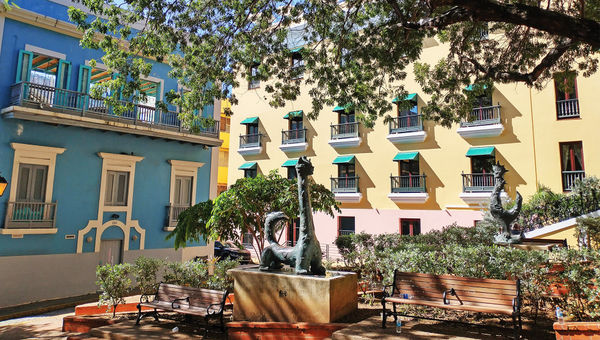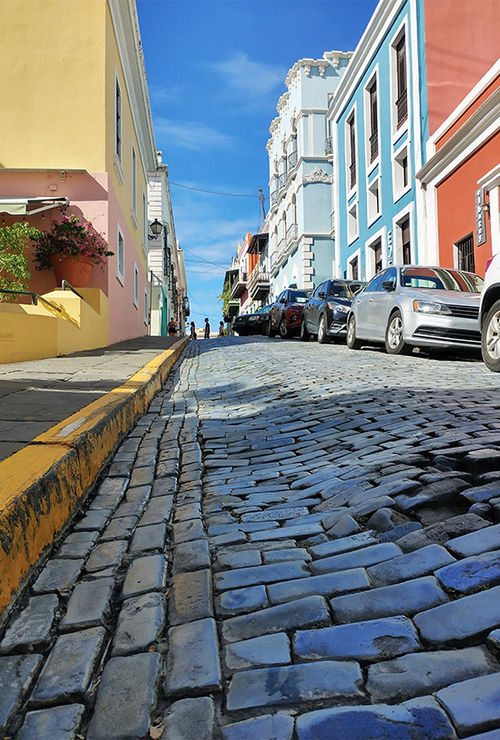Old San Juan is a destination that visitors can enjoy at their own pace. With its cobblestone streets and pastel-hued colonial buildings, it offers much to enjoy for those on a brisk walk to one of its many memorable restaurants, churches and historical attractions. But the appeal might be even greater for those interested in lingering a while, immersing themselves in the district's rich past and its culture.
There's history to be found at virtually every turn here. Established in 1521, San Juan offers a plethora of reminders of the city's Spanish origins, from its two forts -- Castillo San Felipe del Morro, more famously known as El Morro, and Castillo San Cristobal -- and grand houses of worship (La Catedral de San Juan Bautista and Iglesia de San Jose) to the Plaza de Armas, which serves as the heart of Old San Juan, designed as such by the colonial Spaniards. In all, there are more than 400 buildings that date to Spain's colonization of the island.

Plaza de la Catedral dates to 1521 and is located in front of La Catedral de San Juan Bautista. Photo Credit: Omar Perez
On a recent visit I found my way to Cristo Street, where I came upon the Plaza del Quinto Centenario, which was dedicated in 1992 to mark Christopher Columbus' first voyage to the "New World"; the spot yielded views of the waterfront Santa Maria Magdalena de Pazzis Cemetery as well as the nearly 500-year-old El Morro, which was the ultimate destination on my afternoon stroll.
The fort, built between the 16th and 18th centuries, bears the scars of five attacks by the Dutch, French and English, the first of which occurred in 1595. These scars present themselves, as does the grandeur of the place, as you approach El Morro along a moderately uphill esplanade that spans as far as the eye can see.
Inside there are six levels to explore, including opportunities to view colonial kitchens, soldiers' living quarter, a chapel and cannon emplacements, providing grand views across Old San Juan and the sea. Steep circular stairs and ramps once used to move artillery connect the levels and lead to weathered nooks and crannies, offering hours of exploration opportunities for children of all ages. Those with mobility issues may opt for the ramps.

An undulating cobblestone street in Old San Juan. Photo Credit: Omar Perez
Daylong admission is $10 and also includes entry to Castillo San Cristobal, the largest Spanish fortification in the Americas. Guided tours of El Morro also are available. Both sites are part of the National Park Service and accept various annual passes.
A walk down the popular Fortaleza Street, which takes its name from the governor's mansion located there, is a must. The westernmost area of the street is known for being decorated at various times with everything from suspended, colorful umbrellas to kites or a sprawling Puerto Rican flag.
Another must-see spot in Old San Juan is Parque de las Palomas (Pigeon Park). Located next to the 18th-century Capilla del Cristo chapel on Cristo Street, just off Fortaleza Street. The park is reminiscent of Trafalgar Square or Piazza San Marco, with hundreds of the birds swarming delighted children -- or any visitor, for that matter, who has some breadcrumbs to offer. For guests feeling a bit peckish themselves, the adjacent Cafe del Nino serves coffee and an array of treats and is also a place to take in some magnificent views of the Bay of San Juan.

In Parque de las Palomas, tourists share the space with hundreds of pigeons. Photo Credit: Omar Perez
In pursuit of souvenirs, it was a relief to find stores selling gifts of substance, like handmade arts and spices, rather than trinkets like Puerto Rico towels and T-shirts. Two shops that caught my attention on Fortaleza Street were the Artisan Corner and Puerto Rican Art & Crafts, both selling wood and canvas creations as well as consumables like artisan rums and hot sauces not widely available in the States.
Fast-food joints are scarce in Old San Juan, with local eateries ruling the day. I took full advantage, opting for Raices Restaurant, two blocks south of Fortaleza Street, where I tried one of the island's staples: mofongo. Our table ordered two versions, churrasco and vegan, both of which were served in a plantain-encrusted cup. The restaurant's colorful native artwork and murals along with the village construction added to the Boricuan experience.
Though it is a very busy tourist area, I found prices in shops and restaurants to be much more reasonable than in a number of other destinations I've visited.